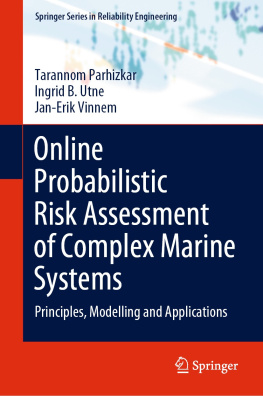Springer Series in Reliability Engineering
Series Editor
Hoang Pham
Department of Industrial and Systems Engineering, Rutgers University, Piscataway, NJ, USA
More information about this series at https://link.springer.com/bookseries/6917
Tarannom Parhizkar , Ingrid B. Utne and Jan-Erik Vinnem
Online Probabilistic Risk Assessment of Complex Marine Systems
Principles, Modelling and Applications
1st ed. 2022

Logo of the publisher
Tarannom Parhizkar
Department of Marine Technology, Norwegian University of Science and Technology, Trondheim, Norway
B. John Garrick Institute for the Risk Sciences, University of California, Los Angeles, CA, USA
Ingrid B. Utne
Department of Marine Technology, Norwegian University of Science and Technology, Trondheim, Norway
Jan-Erik Vinnem
Department of Marine Technology, Norwegian University of Science and Technology, Trondheim, Norway
ISSN 1614-7839 e-ISSN 2196-999X
Springer Series in Reliability Engineering
ISBN 978-3-030-88097-2 e-ISBN 978-3-030-88098-9
https://doi.org/10.1007/978-3-030-88098-9
The Editor(s) (if applicable) and The Author(s), under exclusive license to Springer Nature Switzerland AG 2022
This work is subject to copyright. All rights are solely and exclusively licensed by the Publisher, whether the whole or part of the material is concerned, specifically the rights of translation, reprinting, reuse of illustrations, recitation, broadcasting, reproduction on microfilms or in any other physical way, and transmission or information storage and retrieval, electronic adaptation, computer software, or by similar or dissimilar methodology now known or hereafter developed.
The use of general descriptive names, registered names, trademarks, service marks, etc. in this publication does not imply, even in the absence of a specific statement, that such names are exempt from the relevant protective laws and regulations and therefore free for general use.
The publisher, the authors and the editors are safe to assume that the advice and information in this book are believed to be true and accurate at the date of publication. Neither the publisher nor the authors or the editors give a warranty, expressed or implied, with respect to the material contained herein or for any errors or omissions that may have been made. The publisher remains neutral with regard to jurisdictional claims in published maps and institutional affiliations.
This Springer imprint is published by the registered company Springer Nature Switzerland AG
The registered company address is: Gewerbestrasse 11, 6330 Cham, Switzerland
Preface
This book provides a general framework for online risk assessment considering human, software, and hardware interactions in automated and autonomous complex systems, with particular focus on marine applications. There is a significant interest in industry, authorities, and academia on the prospects of complex autonomous systems. Much work focuses on technological developments and discussions on economic, legal, and safety implications. There has been less focus so far on risk assessment and modeling concerning the conceptualization, design, and, in particular on the safe operation of these systems.
The safe operation of automated and autonomous complex systems requires close coordination between human operators, organization, and the technical systems and components. Often, both the systems and human operators face dynamic decision-making conditions with incomplete information and little time to consider options. Sophisticated techniques and methodologies have been developed to analyze different complex systems, and advances have been made in fundamental issues. Most of the current techniques for risk assessment, however, largely rely on a static analysis of a complex system. Unfortunately, static analyses cannot capture the dynamic factors and feedback loops that influence the system behavior of automated and autonomous systems.
In recent years, simulation-based approaches have been proposed that capture dynamic interactions and couple the human, hardware, and software performance to provide a better prediction of hazardous events and evaluation of risks related to operator(s) and system behavior. So far, such methods have been mostly utilized for nuclear power plants and for space missions. There is a growing need for dynamic and online risk assessment tools capable of providing information about risk for decision support of automated and autonomous systems, for example, in the marine domain. This demand is due to the increase of autonomous functionality that is being incorporated, which makes systems more complex and risk assessment more challenging. Furthermore, trust and approval by authorities and the public require safe design and operation of the autonomous systems.
The main intended audiences of the book are marine, maritime and offshore petroleum industry professionals, aerospace industry professionals, nuclear power industry, consultants, authorities, researchers, and graduate students in the field of engineering, in particular for those interested in risk and reliability assessment of complex systems. The framework of this book could be used in the design of decision support tools to help operators make better decisions; for development of supervisory risk control and improved intelligence of autonomous systems, and generally, to improve complex systems safety.
The content of the book has been researched and developed by the authors over several years in different research and industry projects. A major leap forward, however, was achieved from 2018 to 2020 when Dr. Parhizkar was a postdoc at the Norwegian University of Science and Technology (NTNU).
Tarannom Parhizkar
Ingrid B. Utne
Jan-Erik Vinnem
Trondheim, Norway
Abbreviations
ADAPT
Analysis of dynamic accident progression trees
ADS
Accident dynamic simulator
AHTS
Anchor handling
AI
Artificial intelligence
AROVs
Autonomous remotely operated vehicles
ATHEANA
A technique for human event analysis
BN
Bayesian network
BVP
Blood volume pulse
CAISO
California Independent System Operator
CAMEO
Cognitive and action modeling of an erring operator
CES
Cognitive environment simulation
COSIMO
Cognitive simulation model
CREAM
Cognitive reliability error analysis method
CS
Complex system
CSRM
Context-based software risk assessment Methodology
DBN
Dynamic Bayesian network
DC
Disconnection
DESDs
Dynamic event sequence diagrams
DFM
Dynamic flow graph methodology
DGPS
Differential Global Positioning System
DP
Dynamic positioning
DPO
Dynamic positioning operators
DPRA
Dynamic probabilistic risk assessment
DSV
Diving support vessels
DYLAM
Dynamical logical analytical methodology
ESD(s)
Event sequence diagram(s)
ESD
Emergency shutdown
FMEA
Failure mode and effect analysis
FPSOs
Floating production storage and offloading
FSL
Flow state logic
FSUs
Floating storage units
FTA








